OBSTACLE GUIDELINES
The UHCA strives to create courses that allow all participants to have success with challenge in their rides. Below is a guide consisting of some of the obstacles used in past events. Several of the obstacles can be arranged to allow for different degrees of difficulty. Creative courses are encouraged but safety should be kept as a major consideration. The list of potential obstacles is extensive and event host are quite creative; a rider may encounter obstacles not specifically listed here.
- Backing
a. Straight shoots
b. An ‘L’ or‘V’
c. A serpentine pattern through cones
d. In and out of 3 barrels
e. Up or down a slope
- Ball (large) Movement to a designated area or goal by using horses leg
a. Front legs
b. Back legs
- Bareback riding for Open division; Can be in conjunction with other obstacles.
- Barrels and Board – a 12’ board with a rope or metal handle on one end is laid on two barrels with centers 10’ apart. Rider picks up handle end of board and rides all the way around the other barrel back to the starting point without letting the board come off the center barrel.
- Bridges:
a. Can vary width, length, and height but Make them Strong!
b. Wide bridge (pedestal) on ground;
c. Narrow or elevated ;
d. 90 degree turns or steps incorporated in bridge(s)
e. Fixed - Higher at far end;
f. Fixed - Enter on high end;
Safety: Try to use a surface that is slip resistant and do not place in the event soon after a water obstacle. (wet, slippery, muddy hooves)
g. Teeter-totter style that tilts as a horse/rider goes across it.
i. Teetering entered from low end;
ii. Teetering entered from high end;
Safety : A notch in bridge structure to keep pivot point consistent. No round pivot log
- Broken Jump: 3 jumps are ‘attached’ to each other to make a ‘Z’ pattern where the angles are 90 degrees. The pattern is set to jump all three sections and should require lead change(s).
- Car wash: Horse must pass between foam noodles attached to two poles. Poles may rotate or not.
- Carry Items: Water bucket, sack of cans, stuffed animal, tarp etc.
Safety: Give consideration as to weight for division(s) involved
- Cattle Work:
a. Cut cattle out of a herd;
b. Move cattle from one area to another;
c. Quietly walk through herd
- Cowboy polo: Moving something like a soccer ball with a ‘mallet’ such as a broom to a hay bale goal or marked area.
- Curtains: Go through an archway with strips of tarp, fabric, foam ‘noodles’.
Safety: Do not use string, thin strips or small rope! They may self tie and hang a horse or rider.
- Daisy chain:
a. Position 4 poles (or cones) in a square about 30’per side. Place a 5th pole in the center. Various patterns can be designed from this placement. The most common is alternating a left turn around the middle pole and then a right turn around an outside pole until all have been used. This is designed to show lead changes, smoothness, uniform pattern etc. Another common pattern is similar to pole bending the diagonal, return to the center, go to a new corner and pole bend the remaining. (Lead changes are important)
b. Position 3 poles 30’ from each other and develop different pattern to take less time.
- Ditch: Ride through a cut about 2-4’ deep in the ground or in a dirt mound
- Doubling a horse into the fence and reversing course; 2 or 3 turns
- Downfall: Horse/rider crosses an area of logs and limbs that are in a jumbled pattern. It is good to have them attached to each other or marked to keep their positions pretty consistent.
- Dragging items.
a. Pick up rope that is tied to an obstacle and drag it around a cone, etc.
b. Dallying prohibited in some classes for safety considerations so those obstacles are lighter.
Safety: Have enough rope available to keep away from horse’s hind feet
Do not have much ‘extra’ rope for lower divisions.
c. Drag item with horse facing the item
- Drop offs: Similar to the step down but is generally one larger vertical distance.
- Flag carry:
a. Pull flag out of barrel, ride a route and place back into barrel
b. Pull small flag out of bucket of sand on barrel and ride a pattern
- Free ride: Often around the perimeter of the course to show varied speeds and control.
- Gates:
a. Rope,
b. metal hinged, right hand, left hand,
c. Pole, various heights and lengths. Note: Once a gate is touched, the rider should not lose contact with it.
i. Pole swung open and closed;
ii. Pole lifted over head and ridden under;
d. Rope;
e. Back through;
f. Hinged, latch in 90 degree corner;
Safety: Gap style gate (non framed) may be dangerous if open enough to trap leg of horse
- Ground tie: the rider dismounts and releases the reins to do a task while the horse remains in that spot. Sometimes an area is marked but best scores are always for a horse that does not move. Tasks can be about anything. (move 2 hay bales, drive a nail in post or board, climb a ladder, pick up a calf dummy, tie a goat etc.)
- Jumping
a. Fixed jumps such as: logs, tubes or barrels; Safety: block the barrels to prevent rolling if hit.
b. ‘Knock down’ jumps such as those on jump standards, edge of hay bales etc
c. ‘coffin’ jump - Sometimes 1’ wide x 1’ deep x 10’ long but can vary and sometimes is much wider.
- Leading a horse on a straight or crooked path
- Leading a blindfolded horse across a sheet of plywood. (A fly mask with duct tape in it or on it can work for a quick on and off mask.)
Note: Leading obstacles used to cross the finish line eliminates the time/ effort of remounting
- Lean down/ Pick up/Drop off: Move a tennis ball from one traffic cone and to another cone.
- Lift and swing: A heavy object (cinder block) is tied to one end of a rope with the other end tied to a tree or pole at a height of about 10’. A second rope is tied to the object and the rider picks up the loose end of that second rope. The rider now has to dally and via backup and side-pass, lift the object and move it to a table, drop it in a bucket etc. Tough.
- Loping over poles
a. Poles (or small logs) can be in a pattern and even spacing or more random
b. Example: Pinwheel: Trotting, loping 4 poles in a spoke pattern (each 90 degrees to the ones next to it)
- Pedestal (Platform) dismount: ride up to platform, log, rock etc. dismount, lead your horse around the platform while you remain on it. Remount.
- Plywood –cross 4x8 sheet of plywood on horseback.
- Pole bending: weaving pattern around poles in a straight line or circle or another design.
- Pony - lead 2nd horse from your horse.
- Rain slicker: pick up or put on or ride with it and place it back on post or barrel.
- Ring Spear: With a broomstick handle (or any 4’- 5’ stick) spear PVC rings as you ride by them. They are generally set on the top of poles about 6’ tall. Control, speed and accuracy are factors.
- Roll backs marked along a fence or something similar; 2 to 4 turns.
- Roll backs with a single or double bale of hay or other obstacle in the middle to jump
- Roping
a. Stationary or moving practice steer.
b. Livestock
c. Your own horse from ground
- Shooting
a. A cap gun from horseback at a target to show correct technique and horse stability;
b. Shoot 45 blanks at balloons. They will break within 12’ or so.
- Side-passing
a. while straddling a single log;
b. An ‘L’, ‘W’, ‘V’ or other pattern
c. With front feet remain in a ring such as a tractor tire side wall. (Pivot on front feet)
Safety note:(if a tire is used , cut it into two ‘C’s rather than an ‘O’ for safety in case it is caught on a horseshoe heel trying to back out of it;
- Spin horse right and left in an area. That area should be at least 12’ across;
- Sprinklers: on ground or elevated but do not have aimed towards horse faces.
- Steps up and/or down. Should have a landing area large enough to jump onto the next step.
- Stops -Precision: Stopping usually from a lope inside a marked area (cones, paint, logs etc.)
- Tarp -Ride over Any color; with or without log border; white logs can make it tougher
- Trailer loading: Often the last obstacle in the series with time stopping upon closing the door or running across a finish line. No riding horse into trailer; No sliding off the horses back by grabbing the trailer roof. Sending horse is highest score; Trailers can vary in all shapes and sizes but keep tall enough for reasonable sizes horses with saddle still on them.
- Trash run: Ride between panels with trash on the ground and tied to the panels
- Trotting over poles. Poles/small logs can be in a pattern with even or random spacing.
- Turn horse around in a marked area;
a. Circle or box shape
b. Keyhole shape
- Water - cross:
a. Ponds, creeks, ditches and puddles .
Safety: Make sure bottoms will not become too boggy after multiple crossings.
- Water Box -cross;
a. Often approximately 4’ x 8’ with 6” wall;
b. Water box with floater: for a 4’x 8’box, a 3 ½’ x 7 ½’ sheet of plywood floating in it; the floating sheet would have holes in it to allow water to squirt up when stepped upon; Safety note: Provide a surface that resists excessive slipping and sliding.
- Wind the clock: Rope a barrel, walk, trot or lope around it until the rope is too short to go farther. Walk is good, consistent trot is better, Lope is best.
DIVISION OBSTACLE RESTRICTIONS
|
Division
|
Bareback
|
Dallying
|
Roping Livestock
|
Trailer
Loading
|
Shooting
|
Jumps
|
Step Up /Down
|
|
Buckaroo
|
No
|
No
|
No
|
No
|
Cap/H2O
|
Max 12”
|
Max 12”
|
|
Youth
|
No
|
Not Req’d
|
No
|
Yes
|
Cap/H2O
|
Max 18”
|
Max 24”
|
|
Novice
|
No
|
Not Req’d
|
No
|
Yes
|
Cap/H2O
|
Max 18”
|
Max 24”
|
|
Classic
|
No
|
Not Req’d
|
Yes
|
Yes
|
All
|
Max 18”
|
Max 36”
|
|
Level 1, 2 & 3
|
No
|
Yes
|
Yes
|
Yes
|
All
|
Max 18”
|
Max 24”
|
|
Colt
|
No
|
Yes
|
Yes
|
Yes
|
All
|
Max 18”
|
Max 24”
|
|
| | | | | | | |
Keep safety for horse and rider in mind in all divisions!
| |
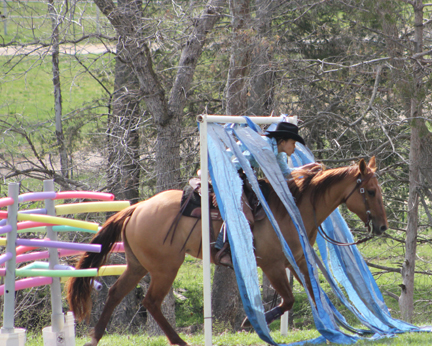 Curtain Curtain
%20(600x487).jpg) Tetter-totter bridge Tetter-totter bridge
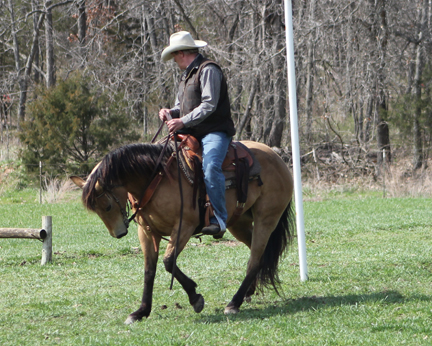 Backing Backing
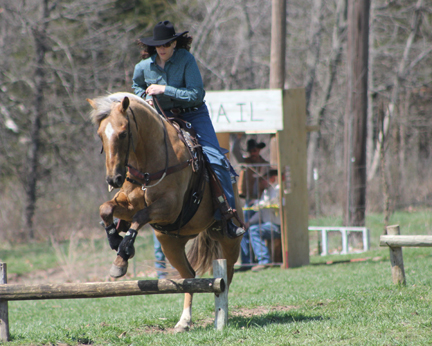 Jumping Jumping
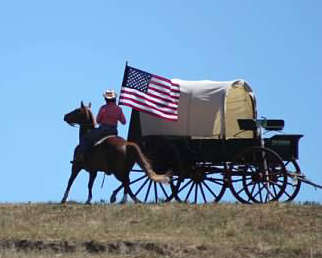
Flag Carry
|
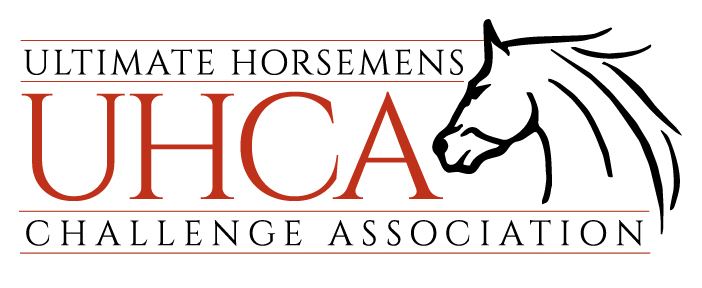
 Curtain
Curtain%20(600x487).jpg)



